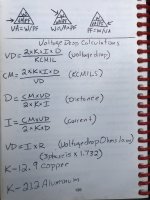Thank you. Why is the 1.05 in different parts of the equation?
This an effect on the conductors resistance at different temperature. I used 15 degree as it relates to 60,75 and 90 c.
Table 8 is based on 75c. For testing this change may effect an ansawer.
You get 1.05 from the coefficient for the conductor material in this case copper. Which is .00323
So let's go back to table 8 and go to the notes. Note 2 gives you this information on conductor coefficient @75c
What it also gives is a weird formula on how to correct for temperature difference Resistance.
What I provided was item to put in your book for testing. Here is a short cut for 1.05.
You can take the 15c change and the coefficient of cu and get close to 1.05.
CU
(15*.000323)+1=1.04845 round up to 1.05
AL
(15*.00330)+1=1.0495 round up to 1.05
I can walk you through the weird equation if you want. I just made a spreadsheet which had the formula account temperature chang in VD.
Once you understand what the formula is asking it's pretty simple.
R2 is the new resistance.
R1 is the table 8@75c.
The 1+ is what I used in the short cut.
a is the coefficient shown for either CU or ALat 75c or temperature coefficient. Which I also used in the short cut.
T2 is the new temperature.
-75 is the 75c.
Another good one is in 310.15 (3)(B)(2)


